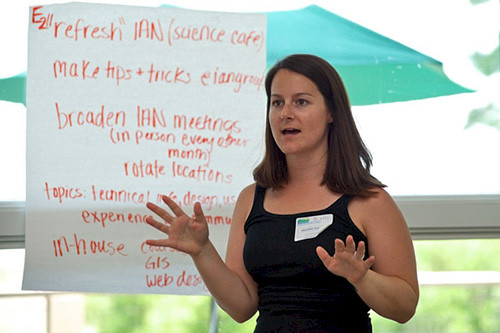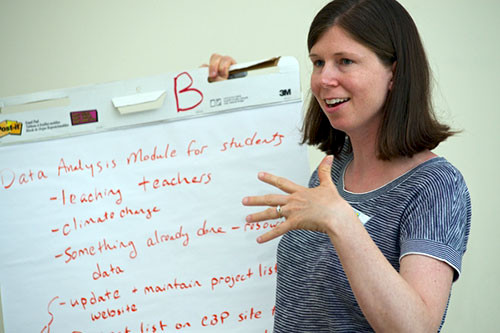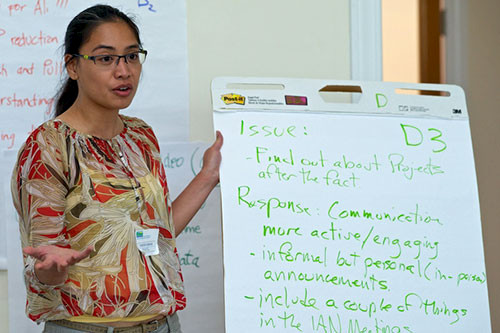Integration and Application Network retreat: June 2014
Bill Dennison ·The Integration and Application Network held a retreat at the Chesapeake Bay Environmental Center on the shores of Chesapeake Bay's Eastern Shore. The venue was spectacular, with views across marshes and open water in a sustainable building that included bamboo flooring, solar power, and skylights.

Our goals were to introduce ourselves to one another, particularly the plethora of new staff, and then develop strategies for regular IAN interactions. IAN staff are distributed in different locations (Cambridge, Annapolis, Baltimore, Canada) and many of them are embedded in various agencies, including the Chesapeake Bay Program, Maryland Department of Natural Resources, Maryland Department of Environment, and Maryland State Department of Education. Staff live in Baltimore, Washington D.C., Annapolis, and a variety of towns on the eastern and western shore of Chesapeake Bay, thus a central location was chosen for the retreat. For our Canadian telecommuters, we had Bill Nuttle in town and Skyped Adrian Jones and Tracey Saxby into the retreat by walking around a computer.
We asked everyone to list up to ten words that describe why they were attracted to IAN, considering that this talented group of people often turned down better paying jobs to work with IAN. Jane Hawkey used the wordle program to generate a word cloud which is shown here.

Everyone produced a three slide introduction of themselves, which were projected with a one minute timer per slide. The ingenuity and creativity applied to this exercise was impressive. There were several common themes that emerged. The overall theme was a desire to make the world a better place, with a focus on the Chesapeake region. People expressed their passions and interests which included adventures like travel, rock climbing, scuba diving and kite sailing, 'geeky' stuff like messing with computers, reading, and photography, as well as experiencing nature via hiking, boating, fishing, and gardening. Some geographical themes emerged as well, with an affinity for Chesapeake Bay, the US west coast, Canada and Australia. IAN folks enjoy good food and drink, travel extensively, and 'get stuff done'. They are energetic, talented and interesting.

Another exercise was to list the various skill sets possessed by members of the IAN team, which created an impressive list of science skills (e.g., data analysis and interpretation, synthesis, statistics, geographic information systems, science writing and editing, computer coding), graphic design skills (e.g., Adobe creative suite, photography, video production, web design, story boarding), stakeholder engagement skills (e.g., developing and maintaining collaborations, workshop facilitation, social media, mobile device apps, responsive web design, user experience), education skills (e.g., teaching, curriculum development, educational resource creation, accessible information) and leadership skills (e.g., project management, transparent administration, recruiting and retaining high quality staff, entrepreneurship). Some specialities like emerged like marine science, evaluating best management practice effectiveness, and studying and communicating climate change impacts, adaptation, mitigation and education.

Another interesting exercise was having everyone complete a Myers-Briggs type personality test and comparing results. The Myers-Briggs test results showed a preponderance of IAN staff are categorized as INTJ (Introversion-Intuition-Thinking-Judgment), which is relatively rare in the general population, particularly women, but many scientists and engineers are in this category. The IAN team also has people in other rationalist categories, some idealists, fewer guardians and only one artisan.

We also brainstormed ideas to enhance our productivity, connectivity and effectiveness. Heath Kelsey and Alex Fries developed a system for rotating five person groups so that everyone was in a group with everyone else just once. We did successive rounds with short report backs that built on what previous groups had come up with. The final round was to prioritize the recommendations. Some of the recommendations include adding people's skill sets in personnel information on the IAN website, mechanisms for increasing interactions among IAN staff (e.g., field trips, training sessions like a photography course, webinars), create 'capacity clusters' for ongoing interactions (e.g., web design and development, GIS, climate adaptation) and develop rewards or 'bounties' to crowd source various inputs (e.g., photographs, diagrams, symbols).

Overall, we left the IAN retreat impressed at the breadth and diversity of talents in the group, a desire to get together more often and a sense of accomplishment for developing some concrete strategies to enhance our productivity, connectivity and effectiveness. Some of the specific commitments identified at the IAN retreat include:
- An annual schedule for IAN interactions
- In person IAN meetings and announcements that will be held at diverse locations
- Increased participation in IAN meetings
- STAR seminar involvement and invitations to all IAN staff
- Creating a knowledge base, or "Bounties" that capture our institutional knowledge and provide a forum for requesting and providing technical assistance
- Identification of specific projects that will allow us to work on something together to leverage and share our skills
About the author
Bill Dennison

Dr. Bill Dennison is a Professor of Marine Science and Interim President at the University of Maryland Center for Environmental Science (UMCES).
Next Post > Dancing with Dugongs video
Comments
-
Allison Dungan 10 years ago
That is a good looking crew!
-
Atika 4 months ago
Thank you for sharing this great information with us, i really appreciate your post!